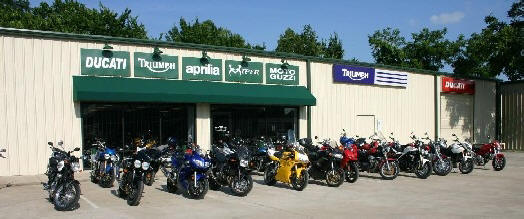PROPER BRAKING!
by Tony Lewis, EuroSport Cycle
Eurosport cycle newsletter - May 2003
In the last newsletter I talked about cornering. In that article I made a brief mention of slowing down as much as possible before the turn. In this article I'd like to break down the steps involved. Braking is one of the hardest things to learn how to do on a motorcycle. I'm not talking about pressing the back brake lever and slowing to a stop. I'm talking about a full scale attack where the front end is down with the tire fighting for traction and the rear end is so light it may even be in the air. Modern motorcycles have incredible brakes and like the handling, there is more there than the average rider can use. The difference is misuse of the brakes can get you into trouble. Leaning a bike over too far or snapping it into a turn too fast are very rare, yet locking one or both ends in a panic is all too common.
Braking is the one area of riding where all five of the controls are used at once, and each control must be used in a measured and changing level throughout the braking process.
The five controls are:
• The front brake
• The rear brake
• The shift lever
• The clutch lever
• The throttle
Most of the time hard braking is used to drop our speed to a proper rate for a given condition, not to come to a complete stop. Therefore, to be in control of the bike at the end of braking we must also downshift while braking. The sequence begins with rolling off of the throttle to begin engine braking, while closing the throttle start squeezing the front brake lever with your first two fingers. At the same time, begin applying the rear brake. Now go for the clutch and down shift. Let the clutch out gradually and open the throttle enough to match your engine rpm with the new lower gear. Use the last two fingers and palm to modulate the throttle while still squeezing the front brake. As you are downshifting, pressure on the front brake should be steadily increasing while pressure on the rear should be decreasing. As the weight of the bike shifts to the front, less rear brake can be used and more front brake should be used. Downshift more if needed, always slipping the clutch out and matching engine rpm to keep the rear tire from locking up. When your speed is correct or you've run out of stopping distance you should be in the proper gear with the clutch out by this time you are probably off of the rear brake completely. Now release the front brake the same way you applied it. Dont "drop" the brake. Let it out quickly but gradually. This should all be done with the bike still upright before entering a turn. The bike should be in a neutral state, with just a little positive-throttle. Practice-practice-practice. Getting on the brakes hard yet controlled is really only half the battle, learning to release them and return to riding is just as difficult. As with all riding techniques, stay loose, don't target fixate and trust your bike. See you on the road.
Tony
EuroSport Cycle
http://www.eurosportcycle.com
Tony & Martha Lewis
3100 Airport Freeway
Fort Worth, Texas 76111-3927
817.838.8135 or 1.800.838.8135
Fax 817.838.3814
Email eurosportcycle@sbcglobal.net

Copyright © 2000 NTNOA All rights reserved.
Revised: January 05, 2018.
|